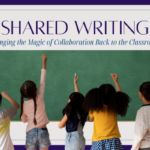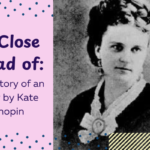As a Literacy Coach, I view my main job as getting kids to love reading. I disliked reading growing up and I hated the REQUIRED reading. No one ever asked me what I was interested in reading, and I never felt I understood what the teachers wanted me to do. It wasn’t until college, when I had a course on Children’s Lit, that I fell in love with reading. It then became my mission to help students like me change their opinion on reading.
Here are some “tricks” I use to help students fall in love with reading:
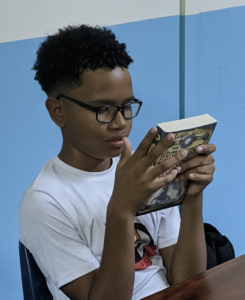 Allow Choice in Text: The easiest move is to allow students to choose what they read. While it’s easy to offer this suggestion, it usually freaks out the teachers I work with. Typically, their main concern is student accountability – how will we know if they are learning the required skills? How will we keep up with all the differences in text and all the other logistical problems?
Allow Choice in Text: The easiest move is to allow students to choose what they read. While it’s easy to offer this suggestion, it usually freaks out the teachers I work with. Typically, their main concern is student accountability – how will we know if they are learning the required skills? How will we keep up with all the differences in text and all the other logistical problems?
These are all solved through conferencing with students. The most powerful teaching in my classroom happens when I’m conferencing one-on-one with a student. I meet with each student each week. A conference can be one minute or five minutes, depending on needs. We discuss the book they’re reading, I ask them questions and we engage in a “normal” conversation about a book. I then ask leading questions that will see if they are capable of reaching the deeper meaning of a book and if they are using basic reading strategies. For example, I might ask, “What do you think will happen next? Why?” “Why do you think she did that? What will be the consequence of this action?” etc. If I am concerned that their answers are not robust enough or that they might not be understanding the text, I have them read aloud a portion of the book to me in order so I can conduct a formative assessment to hear their fluency, pay attention to their decoding, and then helping them utilize simple comprehension tools with the portion of the text I am now familiar with.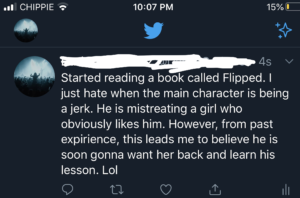 Allow Choice in Response: Allowing choice in how the students respond not only addresses multiple intelligences, it also allows for differences in books. I am NOT a fan of reading logs at all. Instead, my students complete a reader’s response every Friday. They have a choice of 8 ideas (post coming soon!). They have to choose a different response each month. Meaning, for January they had to choose four of the eight ideas, but in February they can repeat the same four. Of course, the response will be different because they are reading different books or in different sections. A few of the choices are Sketchnotes, tweets, character analysis, powerful quotes, and more. These are not LENGTHY responses. Remember, my main goal is to NOT kill reading. They are just illustrating (with words or pictures) a section of their book that “spoke” to them. I have 100% buy-in with a class of 8th graders who were at 50% of turning in reading logs the previous year! Give it a try!
Allow Choice in Response: Allowing choice in how the students respond not only addresses multiple intelligences, it also allows for differences in books. I am NOT a fan of reading logs at all. Instead, my students complete a reader’s response every Friday. They have a choice of 8 ideas (post coming soon!). They have to choose a different response each month. Meaning, for January they had to choose four of the eight ideas, but in February they can repeat the same four. Of course, the response will be different because they are reading different books or in different sections. A few of the choices are Sketchnotes, tweets, character analysis, powerful quotes, and more. These are not LENGTHY responses. Remember, my main goal is to NOT kill reading. They are just illustrating (with words or pictures) a section of their book that “spoke” to them. I have 100% buy-in with a class of 8th graders who were at 50% of turning in reading logs the previous year! Give it a try!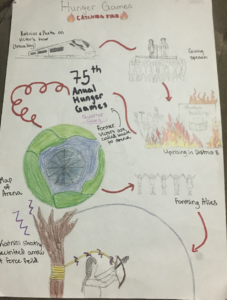 Allow Choice in Genre: If we want our students to improve and enjoy reading, they just need to be reading. Period. They do not need to read The Great Gatsby to become a stronger reader. Students can read magazines, cereal boxes, comics, song lyrics, websites, etc. It is true that I don’t want a student to spend an ENTIRE year reading only graphic novels. However, I will guide the student slowly into different genres. The child who is only reading Sports Illustrated magazines, I might lure with Guys Read: Sports Edition. This book has multiple SHORT stories by popular authors about sports. If (s)he likes one of the stories, I can then transition the student into other books by the same author. Once you have a reading relationship with the student, it’s amazing how much you can convince them to do!
Allow Choice in Genre: If we want our students to improve and enjoy reading, they just need to be reading. Period. They do not need to read The Great Gatsby to become a stronger reader. Students can read magazines, cereal boxes, comics, song lyrics, websites, etc. It is true that I don’t want a student to spend an ENTIRE year reading only graphic novels. However, I will guide the student slowly into different genres. The child who is only reading Sports Illustrated magazines, I might lure with Guys Read: Sports Edition. This book has multiple SHORT stories by popular authors about sports. If (s)he likes one of the stories, I can then transition the student into other books by the same author. Once you have a reading relationship with the student, it’s amazing how much you can convince them to do!
If you haven’t already, consider choice in your Readers’ Workshop. It’s amazing what the results might be!
